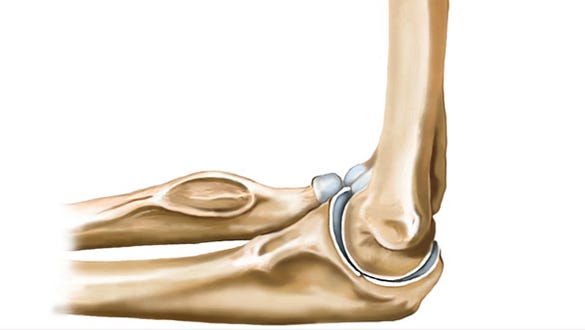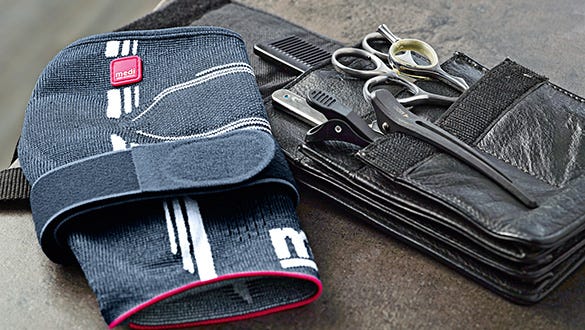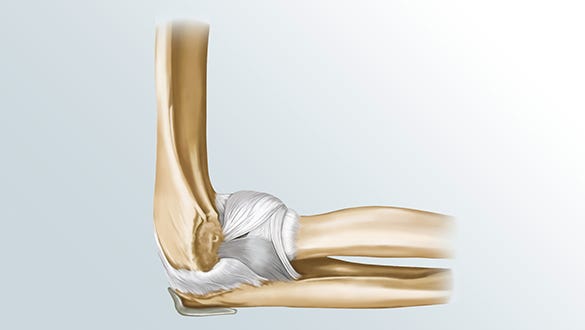- Free First Class Delivery
- Buyer Protection
- Secure Online Shopping
- Healthcare Professional? Click here
Dislocation of the elbow - epicondylopathy and instabilities


Categories
Instabilities and dislocations are one of the most common injuries to the elbow joint
A dislocated elbow is the most common injuries to the elbow. It is the joint which is second most affected by a dislocation and is the most common dislocation in children, particularly when they are lifted or swung by their forearms.
When the joint is dislocated, the ligaments that stabilise the joint are often torn which in turn separate the joint capsule and muscles. The bones are then forced out of alignment.
The diagram shows a right elbow joint viewed from the outside. It also shows the external ligament complex, which consists of several ligaments and can tear in the event of a dislocation.
In severe cases, dislocations can cause both ligaments to tear and bones to fracture, this is known as an elbow dislocation fracture.


Instabilities of the elbow joint
Elbow joint instability is basically a looseness in the elbow joint usually caused by an injury to the capsule, ligaments and muscles, causing the joint to catch, pop or slide out of place during certain movements.
Causes of dislocations and instabilities of the elbow joint
The most common cause of dislocated elbow and elbow instabilities are accidents or traumas of high impact to the joint. When the supporting bones and ligaments surrounding the elbow are placed under additional pressure, they can also become damaged.
Symptoms and signs: Pain and swelling
If the elbow is dislocated, there is a malposition of the joint, and movement is restricted. It will be extremely painful, and the joint will look dislocated with an obvious distortion, followed by swelling. If left untreated, numbness and sensory disturbances or sensitivity problems may occur, which may spread to the arms and hands. Therefore, it is vital to seek immediate medical attention.


Risk factors of a dislocation of the elbow
Try to avoid frequently repeated stresses, for example in overhead sports or take caution when participating in high contact sports. Elbow instabilities can be also a consequence of treatment with cortisone injections or surgery on the elbow.
Preventing dislocations and joint weakness
Falls are hardly foreseeable and therefore are difficult to avoid, therefore, it is difficult to prevent an elbow from becoming dislocated.
Treatment for dislocation and instabilities
Treatment tends to be done gently and slowly. Some dislocations go back into place themselves. Most, however, require a doctor to manipulate the bones back into proper alignment. Once back in place you may need to wear a soft support or a sling for 1-3 weeks followed by early physio exercises.
Soft supports from medi
Therapy for dislocations
Treatment for dislocations: Elbow relocation and after-treatment
The most crucial action after a dislocation is the relocation of the elbow (reposition) to avoid damage – especially to vessels and nerves. This is usually done by a doctor and normally after an X-ray.
Light ligament injuries can be treated as non-surgical (conservative), often using a stabilising brace.
Severe injuries usually require an operation where bones are knit back together again, and ligaments sewn or reinforced by other tendons.
Therapy for instabilities
Therapy for instabilities of the elbow
Depending on the degree of instability, physiotherapy is usually the first port of call. In severe cases, an operation to stabilise the joint is required to ensure painless use of the joint and prevent further damage.
he most crucial action after a dislocation is the relocation of the elbow (reposition) to avoid damage – especially to vessels and nerves. This is usually done by a doctor and normally after an X-ray.
Light ligament injuries can be treated as non-surgical (conservative), often using a stabilising brace.
Severe injuries usually require an operation where bones are knit back together again, and ligaments sewn or reinforced by other tendons.
Physio exercises for treatment after an elbow dislocation
The treatment does not follow a rigid time schedule. Instead, it needs to be adapted according to the capabilities of the patient. Therefore, discuss the exercises, the variations and the difficulty-level with your specialist. Training also helps you to return to the sport you love.
The muscles that stabilise the elbow are first trained in isolation from one another. Over the course of the therapy, different muscle groups are integrated into more complex motion sequences. In the final stage of therapy, before returning to sport, the dynamic exercises are extremely useful.
Training can be done easily at home and requires only household equipment. The exercises should be done three times a day if possible.
Stage 1: Isolation
Biceps curls
Equipment:
- Hand towel
Starting position:
- Sitting on a stable seat
How to do it:
- Pass the towel under your knee.
- Grasp the two ends of the towel.
- Lift your leg by bending the elbow with the towel.
- Do all of this without lowering your leg to the floor.
Variation:
- none
Frequency:
- You control the intensity by the pressure of your leg 1 set x 20 repetitions three times a day
Forearm curls
Equipment:
- 1 kg dumbbell/ alternatively, a drinks bottle with content of approx. 1 l
Starting position:
- Sitting on a stable seat
How to do it:
- Lay your forearm on your thigh.
- Make sure that the palm is facing upwards.
- Bend the wrist upwards.
- Then lower the wrist back down onto your thigh.
Variation:
- Make sure that the palm is facing downwards.
- Rotation of the wrist by 180°.
Frequency:
- 1 set x 30 repetitions (10 repetitions / variation) three times a day
Stage 2: Integration
Bent-over lateral raise
Equipment:
- 1 kg dumbbell/ alternatively, a drinks bottle with content of approx. 1 l
Starting position:
- Standing
How to do it:
- Stand firmly and shoulder-width apart.
- Your knees are slightly bent.
- Bend your upper body forwards slightly.
- Lift your shoulders and upper arms to the side.
- Stretch and bend your elbows.
- The movement takes place only from the elbow.
Variation:
- none
Frequency:
- 1 set x 20 repetitions
- three times a day
Dips
Equipment:
- none
Starting position:
- Sitting on a stable seat
How to do it:
- Lean on an edge for support.
- Lower your hips in front of the seat.
- Then raise your buttocks by stretching your elbows.
- The thumbs should face one another.
- Keep your knees bent.
- Keep your feet on the floor.
Increased level of difficulty:
- Stretch Legs Stretch the hips and legs
Frequency:
- 1 set x 20 repetitions three times a day
Stage 3: Dynamics
Punch with some weight
Equipment:
- 1 kg dumbbell/ alternatively, a drinks bottle with content of approx. 1 l
Starting position:
- Standing
How to do it:
- Stand firmly with your knees slightly bent and shoulder-width apart.
- Lift your hands with the dumbbells to chest height.
- Make sure that the palms are facing upwards.
- Stretch out your arms straight ahead.
- When stretching, turn your palms by 180°.
- Move your outstretched arms back so that they are now close beside your body.
- When you do this, turn your palms back by 180°.
Increased level of difficulty:
- Over the course of therapy, you can increase the impact dynamics and/or the weight.
Frequency:
- 1 set x 20 repetitions
- three times a day
Press-ups
Equipment:
- Yoga blocks / books
Starting position:
- Press-up position
How to do it:
- Place your hands shoulder-width apart onto the floor.
- Keep your knees on the floor.
- Lower your upper body.
- Move your elbows close to your body.
- Your head is in alignment with your spine.
Increased level of difficulty:
- Classic press-ups with raised knees
- Higher repetitions of press-ups
Frequency:
- 1 set x 20 repetitions
- three times a day










